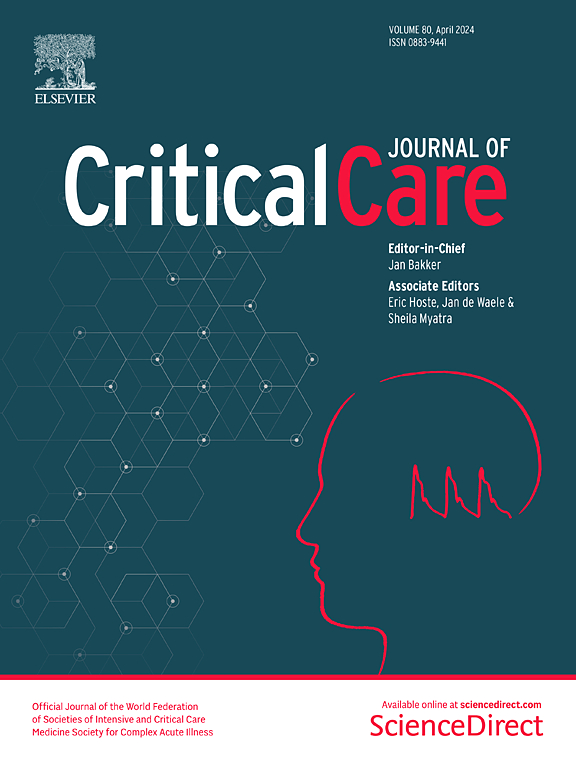预测急性肾损伤肾替代治疗成功释放的新生物标志物:系统综述
IF 8.8
1区 医学
Q1 CRITICAL CARE MEDICINE
引用次数: 0
摘要
肾替代疗法(RRT)是急性肾损伤(AKI)危重患者常用的治疗方法。然而,RRT解放的最佳时机仍然存在争议。这项荟萃分析评估了新的生物标志物,以预测危重AKI患者成功的RRT释放。系统评价报告遵循PRISMA指南,PubMed, Embase和Scopus检索到2025年5月2日,并使用预定义的标准进行筛选。采用纽卡斯尔-渥太华量表评估方法学质量。计算95% ci的合并roc - auc;采用I2统计量评估异质性。纳入16项研究(3020例患者),涉及23种生物标志物。4项研究显示尿中性粒细胞明胶酶相关脂钙蛋白(uNGAL)具有良好的预测性能(AUC 0.766, I2 = 39.8%)。当排除关注长期结果的研究时,结果显示出较好的预测能力,异质性较低(AUC 0.801, I2 = 0%)。血浆前脑啡肽A (PENK)和血清NGAL也显示出潜力,但受研究数量和异质性的限制,定量合成受到限制。截止值也变化很大,使临床翻译复杂化。此外,结合新型生物标志物和临床指标的多变量模型也显示出了良好的预测潜力。然而,由于研究数量有限,结论不一致,需要进一步探索。uNGAL适度预测RRT的短期释放,而其他生物标志物(如PENK)需要进一步验证。标准化成功释放的定义,并将动态生物标志物与临床指标(如尿量)相结合,可以提高预测的准确性。需要进一步的大规模、前瞻性和多中心研究来验证这些发现。本文章由计算机程序翻译,如有差异,请以英文原文为准。
Novel biomarkers for predicting successful liberation of renal replacement therapy for acute kidney injury: a systematic review
Renal replacement therapy (RRT) is commonly used in critically ill patients with acute kidney injury (AKI). However, optimal timing of RRT liberation remains controversy. This meta-analysis evaluates novel biomarkers to predict successful RRT liberation in critically ill AKI patients. The systematic review reported following PRISMA guidelines, PubMed, Embase, and Scopus were searched up to May 2, 2025, and were screened using predefined criteria. Methodological quality was assessed using the Newcastle–Ottawa scale. Pooled ROC-AUCs with 95% CIs were calculated; heterogeneity was evaluated using I2 statistics. Sixteen studies (3020 patients) involving 23 biomarkers were included. Urinary neutrophil gelatinase-associated lipocalin (uNGAL) demonstrated fair predictive performance with 4 studies (AUC 0.766, I2 = 39.8%). When excluding a study focused on long-term outcomes, the result showed a better predictive ability with low heterogeneity (AUC 0.801, I2 = 0%). Plasma proenkephalin A (PENK) and serum NGAL also showed potential, but quantitative synthesis was limited by study number and heterogeneity. The cut-off value also varied widely, complicating clinical translation. In addition, multivariable models combining novel biomarkers with clinical indicators have also demonstrated promising predictive potential. However, due to the limited number of studies and inconsistent conclusions, further exploration is needed. uNGAL moderately predicts short-term RRT liberation, while other biomarkers (e.g., PENK) require further validation. Standardizing definitions of successful liberation and integrating dynamic biomarker changed with clinical indicators (e.g., urine output) may enhance predictive accuracy. Further large-scale, prospective, and multicenter studies are needed to validate these findings.
求助全文
通过发布文献求助,成功后即可免费获取论文全文。
去求助
来源期刊

Critical Care
医学-危重病医学
CiteScore
20.60
自引率
3.30%
发文量
348
审稿时长
1.5 months
期刊介绍:
Critical Care is an esteemed international medical journal that undergoes a rigorous peer-review process to maintain its high quality standards. Its primary objective is to enhance the healthcare services offered to critically ill patients. To achieve this, the journal focuses on gathering, exchanging, disseminating, and endorsing evidence-based information that is highly relevant to intensivists. By doing so, Critical Care seeks to provide a thorough and inclusive examination of the intensive care field.
 求助内容:
求助内容: 应助结果提醒方式:
应助结果提醒方式:


